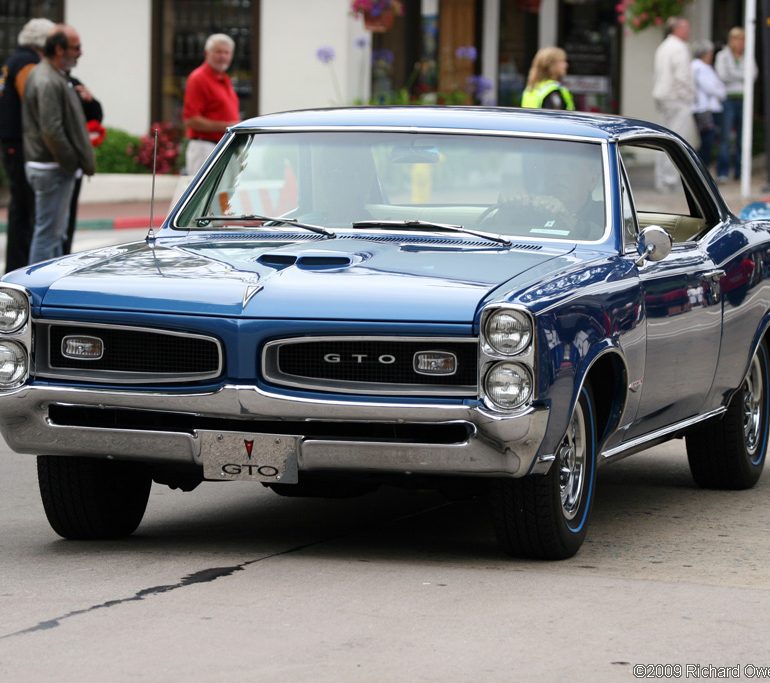1966 Pontiac GTO
In 1966 the GTO became a model in its own right and Pontiac equipped it with the 389 in³ Tri-Power engine which produced 360 bhp. Nearly 97,000 GTOs were sold in 1966 and it became the best selling muscle car. This was largely impart due to the seductive styling of the 1966 model with it’s new coke bottle silhouette.
Other updated details included a mesh-screen grill, dashed rear taillights, stacked headlights and a wooden dashboard. Pontiac offered a wide range of interesting options including power windows, power brakes, power steering, air conditioning and lightweight red inner fenders.
The standard engine produced 335 bhp, and the Tri-Power option increased this to 360. An optional Ram-Air package was offered that was rated at 360 bhp @ 5200 rpm the same as the standard model. 19,045 GTOs in 1966 were equiped with the Tri-Power option.
The regular model could do the 1/4 mile in about 15 seconds and the Ram-Air was slightly faster.
More Details
The 1966 Pontiac GTO, which was a collaboration of three Pontiac Division engineers, the most famous being John DeLorean had controversy written over it. DeLorean named it for a Ferrari car which didn’t set well with automotive purists. But American’s first “muscle car” sold well until the Fed started to meddle with the automotive industry with their restrictive car mandates.
The car was a lightweight-body Tempest compact with heavyweight engine, a 389cid Pontiac V8 from the Pontiac Catalina and Bonneville. With beefed up brakes and suspension and three two-barrel carburetors, sales reached a peak of 95,000 units mainly to power-hungry young drivers who were barely into their third decade of age and who called their car the “goat”.
Features included turn signals in the grille that were meant to copy Europe-made cars, stacked headlights that were retained until 1970, heavy-duty shocks and springs, along with a stabilizer bar, kicked-up rear fender, and a slightly tunneled back light. Interior features included ashtray lights, cigarette lighter, carpeting, and a power top for convertibles.
Options for the interior included Rally Cluster gauges, close-ration four-on-the-floor, center console, walnut grain dash insert. Options for air-conditioning and power steering could set up buyers $343 and $95 respectively. The base 335 bhp could be pushed out to 360 bhp for an extra $116.
In 1964, Pontiac designers debuted the GTO, with a package of options for the Pontiac Tempest, whose goal was to appeal to younger buyers and sell more cars. Created for the performance-oriented customer, the GTO was fitted with a powerful Pontiac 389, a three-speed (optional four-speed) manual transmission with Hurst shifter, firmer suspension, special badging, and upgraded wheels.
The result was one of the fastest American production cars of its time and often credited with ushering in the memorable muscle car era. The GTO became a standalone model in 1966, with more distinctive styling to support building sales. During the next eight years, styling and performance options evolved , selling Pontiac’s performance image to the public, hungry for performance cars.
More Details
- Production 96,946 (1966, all body styles)
- Body Styles Two-door, five-seater hardtop, coupe, and convertible.
- Construction Steel unitary body.
- Engine 389cid V8s.
- Power Output 335-360 bhp.
- Transmission Three-speed manual, optional four-speed manual, or three-speed Hydra-Matic automatic.
- Suspension Front and rear coil springs.
- Brakes Front and rear drums, optional discs.
- Maximum Speed 125 mph
- 0-60 mph 6.8-9.5 sec
Auction Sales History
1966 Pontiac GTO Hardtop Coupe 242176P217751 – sold for $60,500. According to the car’s window sticker, when this 1966 Pontiac GTO Hardtop Coupe was delivered to Ray Steidle Pontiac, of Milford, Ohio, it was equipped with a Tri-Power 389 that was mated to a four-speed manual transmission; the “Ride and Handling” package with heavy-duty shocks and a stabilizer bar; and Rally wheels. It wore Barrier Blue paint with a Blue interior, which is the same color combination it sports today. Documentation accompanying the car suggests that after leaving Ohio, the GTO remained in the Southeastern United States, with owners in Tennessee, Virginia, and North Carolina, before finding its way to the Andrews’s in Fort Worth, Texas. Auction Source: Paul & Chris Andrews Collection by RM Sotheby’s









